Going to exhibitions has always been a geeky guilty pleasure of mine, but when I saw Melbourne Museum’s latest showcase – ‘Revolution: Records + Rebels’, I knew this one was probably going to be the coolest one I’ve ever been to. The 60s is my favourite era of music of all time!
Having come from London’s V&A, the showcase is now in the Melbourne Museum until the end of October 2019.
Exploring 5 explosive years between 1966 – 1970, the Records and Rebels exhibition focuses on the cultural shifts enforced by the liberated and experiential post-war children who have come of age. It’s the 60s we all know and have heard about, but this time you’re thrown head first down the rabbit hole to actually experience it.
The project highlights key subject areas (and locations) that shaped the late 60s revolution: fashion, drugs, sub-cultures, human rights, war, protests, consumerism, festivals… all the while set against an awesome rock & roll soundtrack of the time.
Without mobile phones or personal computers, music (along with the underground press) inspired and gave people a voice to change the world.

1965, the year before the exhibition’s focus, was a very different time for the UK, US and Australia. For example, homosexuality and abortion were illegal; racial discrimination, pay inequality, police murders and entrapment common. Divorce was rarely granted, media and arts censored and a woman had to be married to be granted the pill.
In just 1,826 days, optimistic idealism motivated people to come together to challenge these Western values and power structures across all areas of society. Revolutions took many forms – the exhibition explores not only those changes that held, but also those that faded in subsequent decades.
So what is the exhibition actually like and what can you see here?
An Immersive Sonic Experience
As you approach the exhibition entrance desk, you are handed a set of Sennheiser headphones. When you navigate the space, a curated soundtrack plays in real time, dropping the needle on tracks by artists such as Nina Simone, Bob Dylan, The Rolling Stones and The Who.
The crackle of the needle between the tracks is a nice touch, but having been to the Bowie exhibition in London which was created by the same company, I did think there would be a bit more audio around the actual exhibition pieces. I also found music playing from the speakers in the room at the same time a bit annoying (perhaps it could just be quieter or the headset set louder?) Despite this, more than once I found myself singing and spontaneously bobbing along like I was at a silent disco. In fact, probably throughout!
Instead of just staring disengaged at objects through glass, I love how exhibitions are becoming more interactive and immersive. The accompanying soundtrack to transport your mind at the Records and Rebels exhibit, gives you all the feels!
The Sounds of Woodstock Festival
One room – dedicated to the Woodstock Festival – is where visitors need to whip off the headset. Broadcast on three huge screens in a darkened cube-shaped room, the Festival footage is an epic soundscape and visual overload of one of the world’s most iconic music events.
A documentary on Woodstock, where much of this footage originates, cost filmmakers $600,000 at the time, but it grossed over $50 million in the US alone. This documentary further spread the idealism and counter-culture at the core of Woodstock across the world.
On the main screen, each impassioned riff by Hendrix roars into the very guts of you. Hippy festival goers bathing in the sun, painting faces, swimming in rivers and smoking weed, play in unique transitions on the other screens. A sort of psychedelic montage of the artists and festival life.
You can pull up a large bean bag and lie back for as long as you want in the room, absorbing the the stirring sound porn you’re immersed within.


Beatlemania
As a huge fan of the Beatles, I was excited to see the second room of the exhibition transport you to London’s ‘underground’ music scene and explore the Beatles band phenomenon.
The British psychedelic style, which is probably one of my favourite genres of music, was actually first initiated by the Beatles. Having taken a 3 month break in 1966, the band experimented with mood-altering drugs and avent garde techniques, then incorporated such influences into their music. Electronic techniques such as tape loops and playing tapes backwards brought a new kaleidoscope of styles and emotions to music.
So many pivotal and iconic items have been included as part of the exhibition: John Lennon’s glasses, the suit worn on the cover of ‘Sgt. Pepper’s Lonely Hearts Club Band’, Mick Jagger’s iconic jumpsuit, original illustrations and, my two favourite pieces, handwritten lyrics to ‘Lucy in the Sky with Diamonds’ and the history-making break-up letter to EMI by Paul McCartney. Yes – the actual letter that ended 10 years of the biggest pop obsession the world has ever seen!
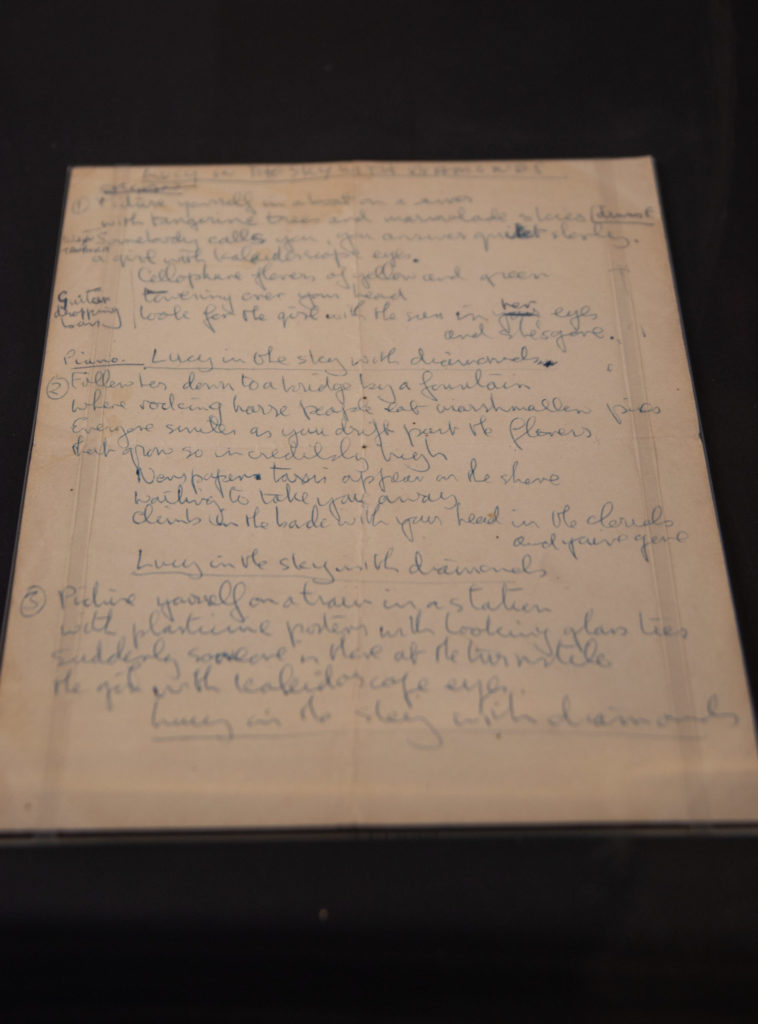
From the haircuts that the older generation mocked, refusing to play at racially segregated shows to the sometimes cheeky and openly politically charged lyrics, the Beatles (as well as bands like the Rolling Stones) became an emblem of rebellion to the burgeoning youth culture.
The Influence of LSD
There’s no denying that LSD was one of the major transformational agents in 1960’s culture. Although mainly used and popularised by pop musicians, the effects of LSD were disseminated internationally throughout the media.
In Britain, it was only in the 1960s that many youths had disposable income. Full employment triggered the growth of a new ‘alternative’ consumer society, allowing the younger generation to spend money on their interests such as flamboyant clothes, music and drugs.
It is clear from the exhibits that it was the recreational use of drugs that consequently channelled into so many aspects of counter-culture, setting the young people apart from their parents and, of course, from the authorities.

The Records & Rebels exhibit delves into how the recreational taking of LSD undermined the very fabric of society. In its mind-altering sensory intensity, LSD emphasised to users that every day reality was just a construct and there could even be more to life than what initially meets the eye.
If in everyday reality, only a small amount of the senses are used, who know’s what else in life is unknown?

Consumerism
From a corridor plastered with anti-war sentiments displayed as badges and posters, comes the next room – a different kind of shock – the brightly coloured overload of adverts and a sinister vision of consumerism.
The exhibition seems to highlight the contradicting nature of consumerism. The 1960s saw an apparent boom in many industries: flying and holidaying for leisure, fashion, imported goods and a desire for luxury goods over simple utilitarian products.
However at the same time, there’s an antipathy toward consumerism – it’s corrosive and destructive nature and the fear of fuelling a perilous capitalist culture.
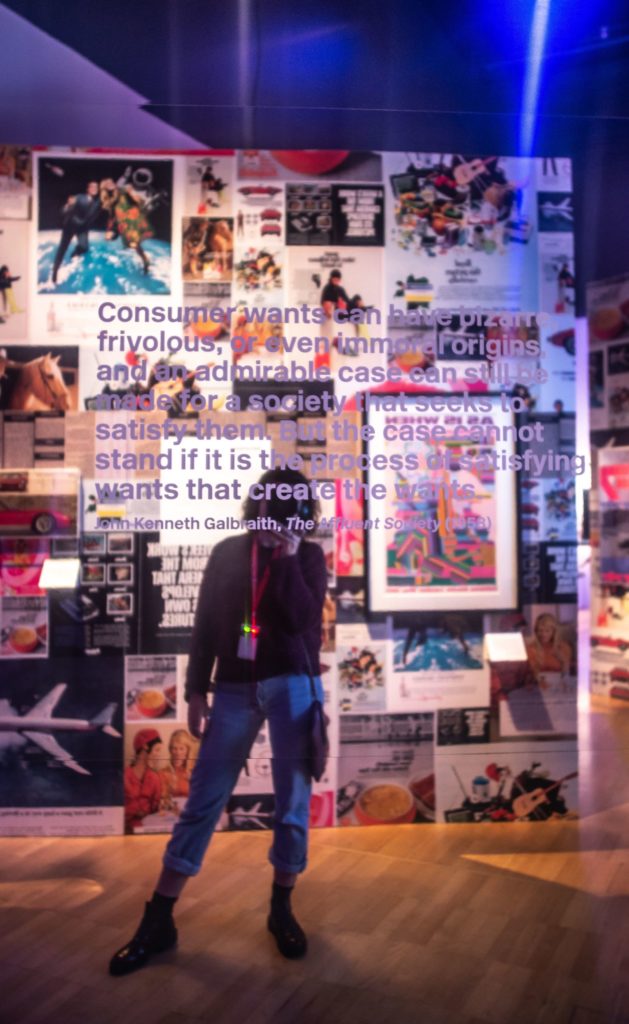
Many musicians at the time, their faces plastered on products such as stockings and talcum powder, battled with the negatives that came with their fame.
Their discomfort at actively fuelling a consumer-driven society whilst also trying to rebel against it through their music (which was also controlled by their producers and record labels) made many musicians question society’s constructs altogether.
The Future Is…?
The last room of the exhibit is blindingly white and bright. John Lennon’s ‘Imagine’ is played on repeat. The effect is ambiguous. Perhaps it’s an optimistic and hopeful end? Or is all not as it seems?
Just as you exit the Records and Rebels exhibition there’s a video – a fast forwarding through time at a rather disorientating pace. There are flashes of protests, gruesome scenes of the Vietnam war, hypnotised children watching TV, OD’ing hippies, the Sony Walkman and globally dominating brands like Coca Cola.
You leave with an overwhelming sense of what these five years achieved but also an unease – was this all just an ideology and did things really change as much as people thought or, indeed, hoped?
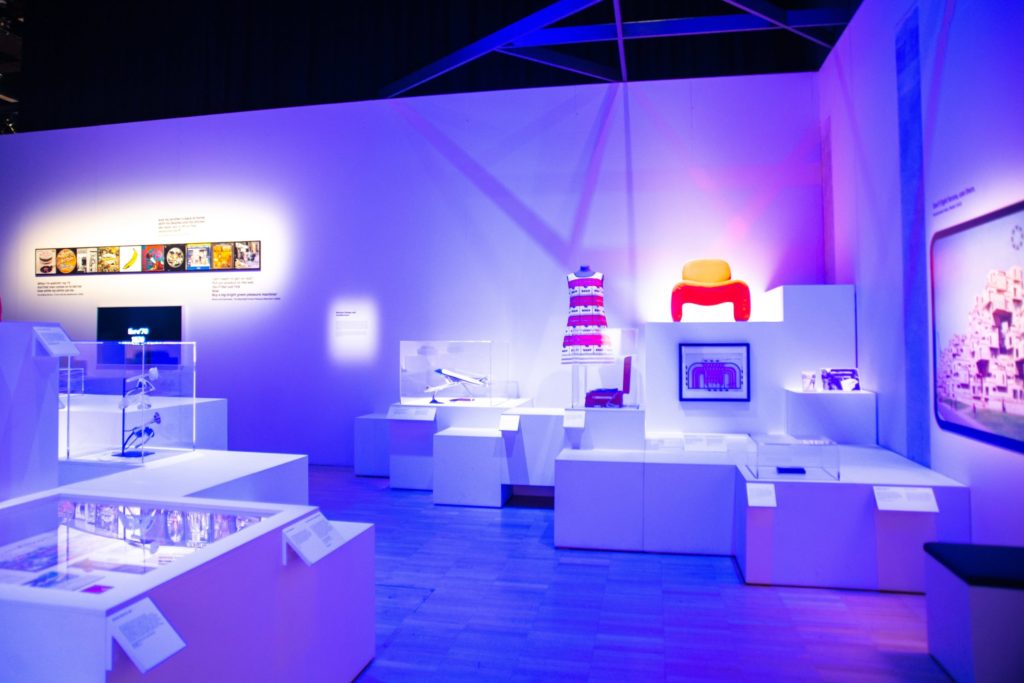
The Melbourne Museum have added a few Australian elements to the exhibition (such as a section on the 1967 Aboriginal rights referendum) but they are all somewhat dwarfed by the UK and US events.
Despite this, 46% of Australia’s population was under the age of 25 in 1966 and it is clear they too felt some of the same shock waves experienced elsewhere in the world.
If you’d like to know a bit more about the Records & Rebels exhibition, check out the promotional video below.
You can find out more about this Records and Rebels exhibition and others on the Melbourne Museum website.
Have you been to this exhibition or if you were in Melbourne, would you want to go? Let me know by leaving me a comment!
Heading to Australia soon? Don’t forget these essentials!
Lonely Planet’s guide to Australia or Lonely Planet’s guide to Tasmania.
Got travel insurance? Make sure you’re covered for any unplanned situations. I use and would recommend World Nomads.
Organised your visa? Don’t forget to check the entry requirements for Australia on the government website for the passport you are travelling with.
Book your accommodation to Hobart or Launceston through Booking.com or Hotels.com.
To search and compare the best group tours and activities worldwide (with up to 50% off), use TourRadar.
For some travel inspiration for your next trip, how about Lonely Planet’s top 500 places to see… ranked?
PIN ME FOR LATER:

*This post may contain affiliate links meaning should you purchase a product via this link, I’ll earn a small commission at no extra cost to you. These are still products I use or believe in regardless. See my privacy and disclosure policy for more.*


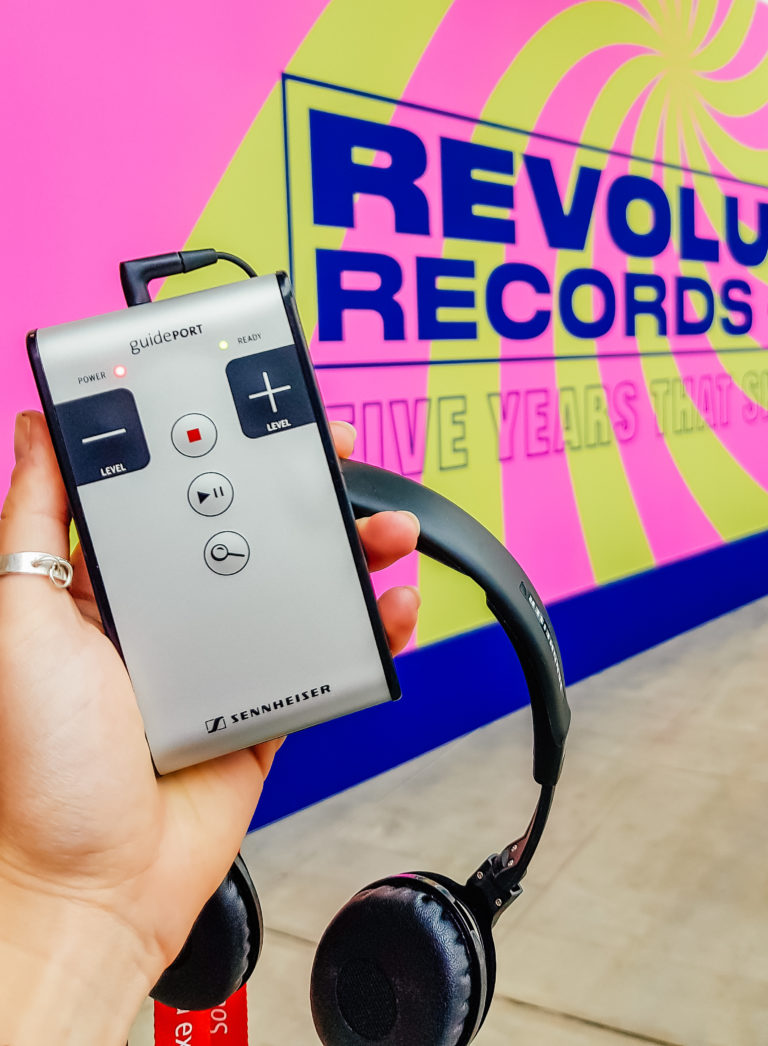


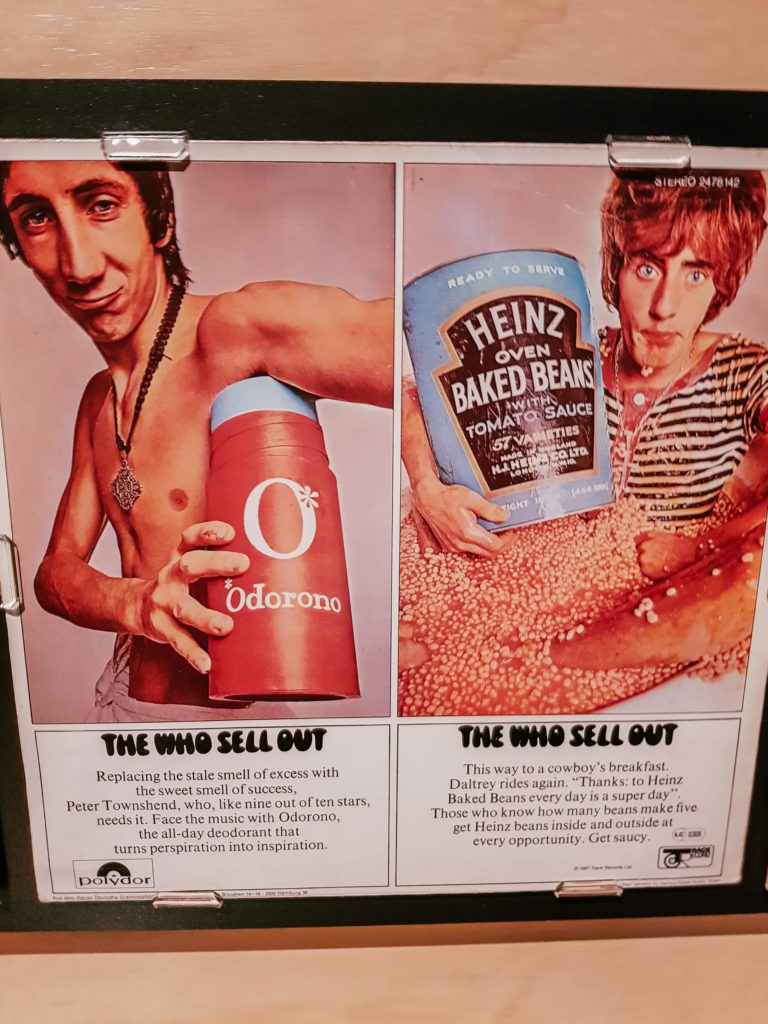
Looks like such an interesting exhibit! I also love it when museums are more interactive. It makes it more fun! And also the Woodstock Room – for some reason I’ve always had a weird fascination with Woodstock (even though I’m not a ‘music festival’ person and probably wouldn’t have attended anyway lol) and I love learning about it.
Exactly! And I think music is one of the most simple ways to make an exhibit interactive! I too have a bit of an obsession with Woodstock. It was such a pivotal event in history with some of the most iconic acts in the world, but from an event management perspective, an event we have learnt so much from also, as it wasn’t all as cool and cruisey as it seemed!
That’s lovely. I cannot believe I missed it when it was a the V&A! Thanks for helping me catch up!
Hopefully it comes back to the UK!
That’s so interesting, especially the part about consumerism! Thanks for sharing this 🙂
Thanks for your comment Pauline!
This looks so cool! I’m nowhere close to Australia at the moment, and I missed it in London… Maybe I’ll catch it in it’s next destination? 🙂 Super cool discovery, so glad I came across your post!
I think it does move around a bit – it would be a total shame if it wasn’t continuing it’s world tour! Thanks for you comment!
This was fascinating! I especially enjoyed the parts about LSD and consumerism – sounds like a really cool exhibition 🙂
I’m glad, thanks Dani. And it was – it’s been my favourite to date I’d say!